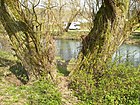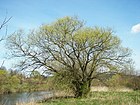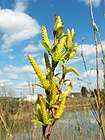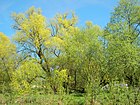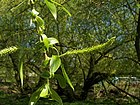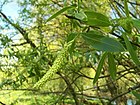Note: This is a project under development. The articles on this wiki are just being initiated and broadly incomplete. You can Help creating new pages.
Salix alba - White willow
Salix alba is a species of willow native to Europe and western and central Asia. The name derives from the white tone to the undersides of the leaves.
Contents
[hide]- 1 Uses
- 2 Parts Used
- 3 Chemical Composition
- 4 Common names
- 5 Properties
- 6 Habit
- 7 Identification
- 8 List of Ayurvedic medicine in which the herb is used
- 9 Where to get the saplings
- 10 Mode of Propagation
- 11 How to plant/cultivate
- 12 Commonly seen growing in areas
- 13 Photo Gallery
- 14 References
- 15 External Links
Uses
Fevers, Dyspepsia, Joint pain, Rheumatism, Arthritis, Gout, Immune diseases, Headache, Febrifuge
Parts Used
Chemical Composition
The inner bark of the White Willow(Salix alba L.)contains tannins, flavonoids, phenolic glycosides, and anti-inflammatory and fever-reducing salicylates.[1]
Common names
| Language | Common name |
|---|---|
| Kannada | Niranji |
| Hindi | Bod, Bains |
| Malayalam | Arali, Atrupala |
| Tamil | Atrupalai |
| Telugu | |
| Marathi | NA |
| Gujarathi | NA |
| Punjabi | NA |
| Kashmiri | NA |
| Sanskrit | |
| English | Indian Willow |
Properties
Reference: Dravya - Substance, Rasa - Taste, Guna - Qualities, Veerya - Potency, Vipaka - Post-digesion effect, Karma - Pharmacological activity, Prabhava - Therepeutics.
Dravya
Rasa
Tikta (Bitter), Kashaya (Astringent)
Guna
Laghu (Light), Ruksha (Dry), Tikshna (Sharp)
Veerya
Ushna (Hot)
Vipaka
Katu (Pungent)
Karma
Kapha, Vata
Prabhava
Habit
Identification
Leaf
| Kind | Shape | Feature |
|---|---|---|
| Simple | Lobed or unlobed but not separated into leaflets |
Flower
| Type | Size | Color and composition | Stamen | More information |
|---|---|---|---|---|
| Unisexual | 2-4cm long | Yellow | 5-20 | Flowers Season is June - August |
Fruit
| Type | Size | Mass | Appearance | Seeds | More information |
|---|---|---|---|---|---|
| General | 7–10 mm | The fruit is dry and splits open when ripe | Bark of an adult plant is ridged or plated | Many | {{{6}}} |
Other features
List of Ayurvedic medicine in which the herb is used
Where to get the saplings
Mode of Propagation
How to plant/cultivate
A very easily grown plant, it succeeds in most soils, including wet, ill-drained or intermittently flooded soils[21], but prefers a damp, heavy soil in a sunny position[22]. Rarely thrives on chalk[22] and dislikes poor thin soils[23]. Very tolerant of maritime exposure and atmospheric pollution.[3]
Commonly seen growing in areas
By streams and rivers, marshes and woods, wet fens on richer soils.
Photo Gallery
References
External Links
- Ayurvedic Herbs known to be helpful to treat Fevers
- Ayurvedic Herbs known to be helpful to treat Dyspepsia
- Ayurvedic Herbs known to be helpful to treat Joint pain
- Ayurvedic Herbs known to be helpful to treat Rheumatism
- Ayurvedic Herbs known to be helpful to treat Arthritis
- Ayurvedic Herbs known to be helpful to treat Gout
- Ayurvedic Herbs known to be helpful to treat Immune diseases
- Ayurvedic Herbs known to be helpful to treat Headache
- Ayurvedic Herbs known to be helpful to treat Febrifuge
- Herbs with Leaves used in medicine
- Herbs with Inner bark used in medicine
- Herbs with common name in Kannada
- Herbs with common name in Hindi
- Herbs with common name in Malayalam
- Herbs with common name in Tamil
- Herbs with common name in English
- Habit - Deciduous tree
- Index of Plants which can be propagated by Seeds
- Herbs that are commonly seen in the region of By streams and rivers
- Herbs that are commonly seen in the region of marshes and woods
- Herbs that are commonly seen in the region of wet fens on richer soils
- Herbs
- Ayurvedic herbs that don't have flower, fruit and leaf photos
- Ayurvedic herbs that don't have seed photos
- Salicaceae

